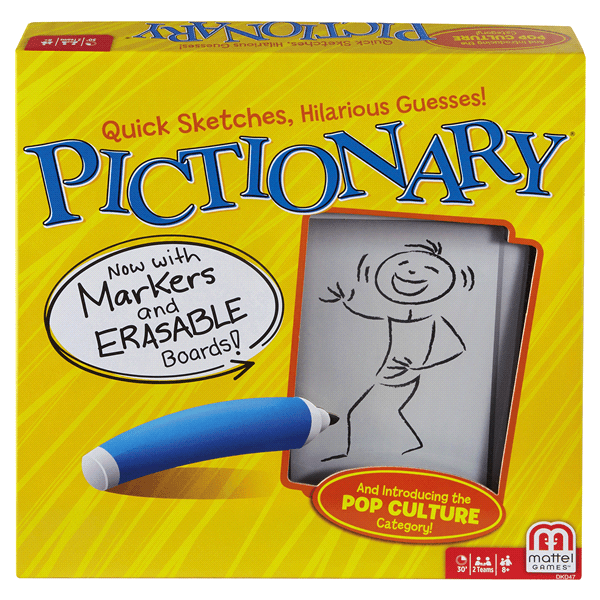
![]() Pictionary is a game that is meant to be fun for the whole family (as long as members can read and hold a pen). This idea of universal play along with the theme of drawing and guessing is enhanced with primary colors; the strong presence of yellow contributes to the game’s happy, upbeat feel. This, along with the unbalanced font, makes the game almost feel like you’re back in elementary school. These choices succeeded in making the game accessible and approachable for players of all ages and abilities.
Pictionary is a game that is meant to be fun for the whole family (as long as members can read and hold a pen). This idea of universal play along with the theme of drawing and guessing is enhanced with primary colors; the strong presence of yellow contributes to the game’s happy, upbeat feel. This, along with the unbalanced font, makes the game almost feel like you’re back in elementary school. These choices succeeded in making the game accessible and approachable for players of all ages and abilities.
The mechanics of this game afford players the tools to communicate their drawing to their team: a paper (or dry erase board) and marker, and a deck of cards with words to draw from. Another important mechanic is that players know what category their teammate’s word is in (people, places, animals, etc.) so they’re not just guessing among all possible words. The dynamics of Pictionary include a time pressure component, where each team only has 1 minute to guess the drawing. Teamwork is also a crucial dynamic in this game, as teammates have to work together to correctly guess the drawing. The formal elements of this game make it extremely similar to charades: it is multi-player, split up into teams. Teams try to guess the word being drawn (acted out in the case of charades). There are also clear boundaries: you can’t write any words on the paper. Similarly, in charades, you can’t say any words aloud.
Pictionary promises 3 types of fun: fellowship, challenge, and expression. Players have to work together to successfully identify the drawing. The person who is drawing is faced with the challenge of creating a drawing that best captures the essence of their word. With only 1 minute, they have to make choices in this area. If their phrase is “baseball game”, do they start with the stadium, or the ball and the bat (see image below)? This person is also able to express their creativity in their drawing.

Pictionary handles abuse implicitly — as all of the words on the cards are appropriate, if the player wants to successfully help their team win the game, then they would want their drawing to accurately represent such word. Drawing or writing things that are inappropriate or make other players uncomfortable does not help their team reach the objective. On the other hand, there is no explicit language or drawing moderation as the game is played in-person. If there’s a malicious player, there is nothing stopping them from creating harmful drawings or making outlandish, inappropriate guesses. Thus, abuse is an area of improvement for Pictionary.
While Pictionary does succeed at delivering the types of fun they promise, I think that Pictionary could push expression even further. Right now, the person creating the drawing takes creative liberty over the drawing that they make, but they are bound to the word that they selected. Since the category is already set, perhaps this person could come up with a word themselves to draw. This would enhance the creative aspect of the game. If this change were to be implemented, beyond the word being within the selected category, additional rules such as a word limit could be enforced to maintain standardization of difficulty across cards.



